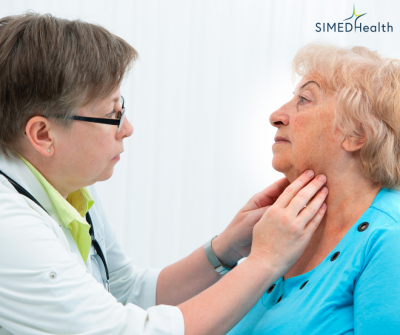
An estimated 20 million people in the United States have thyroid disease, according to the American Thyroid Association. January is Thyroid Awareness Month, and we talked to Larissa Lim, MD of SIMEDHealth Primary Care, about the function of the thyroid and common diseases and treatments.
1. What is the thyroid?
Dr. Lim says, "The thyroid gland is located on the bottom part of the front of the neck. It is composed of two lobes (left and right) and a middle region called the isthmus; some compare the shape to a butterfly."
2. What is its function in the body?
"The gland secretes hormones influencing the growth and maturation of tissues, the functioning of all cells in the body, and our total energy expenditure," explains Dr. Lim. "These energy expenditures include raising or lowering body temperature, the rate of our heartbeat, and activation of the nervous system."
3. What can happen if it stops functioning correctly?
"When the thyroid gland does not synthesize enough hormone, hypothyroidism develops." Dr. Lim says, "In adults, symptoms include fatigue, lethargy, constipation, cold intolerance, muscle cramping and stiffness, carpal tunnel syndrome, weight gain, dry skin and hair, voice hoarseness, and excessive menstruation. Infants with hypothyroidism can develop jaundice, hoarse cry, constipation, drowsiness, and feeding problems."
"On the other hand, problems can also ensue when it produces too many hormones. Hyperthyroidism is the overproduction of the active thyroid hormone thyroxine. Hyperthyroidism symptoms include unintentional weight loss, rapid heartbeat, irregular heartbeat, increased appetite, sweating, difficulty sleeping, increased sensitivity to heat, and anxiety."
4. What are some common thyroid diseases? How are they treated?
- "Goiter is an enlargement of the gland," reports Dr. Lim. "The symptoms include swelling and tightness of the neck, difficulty breathing, coughing, or hoarseness of voice. Most of the time, people experience no symptoms, but if they do, they have several treatment options. They can take small doses of iodine, use radioactive iodine to shrink the thyroid, or have all or part of the gland surgically removed."
- "Grave's disease is an effect of hyperthyroidism. Grave's disease is associated with increased metabolism. It causes the muscles and tissues behind the eyes to swell. When severe causes the eyes to bulge forward," Dr. Lim states, "There is no overall cure for hyperthyroidism, but the symptoms can be controlled. Conventional treatments include beta-blockers, radioactive iodine to eliminate all or part of the gland or complete removal."
- According to the National Cancer Institute, thyroid cancers are generally rare, affecting less than 4% of the population. Dr. Lim explains, "They usually present as nodules measuring more than 1 cm. Treatment is often surgery, sometimes followed by radioactive iodine."
For an appointment with Dr. Lim or another SIMEDHealth Primary Care physician, please click here!